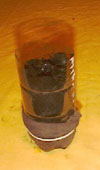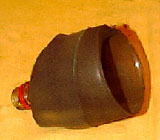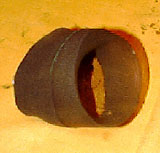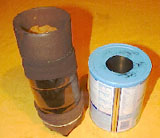




The
system that is described demonstrates the principle of cleaning dirty
water. As a sensible safety precaution, however, under no circumstances
should the water produced from this system be used to make any form of
drinking water.

You
will need the following items:
Materials
- A large pop bottle
- Some charcoal as used in a barbecue
- Sand - use sharp sand which is does not leave a yellow stain
- A large can
- Duct tape
- Elastic bands
- A pair of old stockings or tights
- Scissors

How to make your filter
Be sure you have permission to use scissors before undertaking the project. Also, take care while using them!
1 The charcoal pieces should be small - perhaps a few millimeters in size. If the charcoal lumps are bigger, smash them into smaller pieces until you have charcoal gravel.
2 Cut the bottle in two, about a third way down its length
3
Cut holes in the dimples on the bottom.
 4
4
If using tights cut them into two stockings.
5 Fit a stocking over the end of the larger section of the bottle and secure with an elastic band. This stocking stops the small pieces of charcoal from being washed away.
6
Fill the bottle with charcoal.

7 The top portion of the bottle forms a funnel when it is upside-down.
8
Fit the second stocking inside the funnel and pull the open end around
the outside.

9
Half fill the socking with sand. The socking prevents the sand from
being washed into the charcoal.

10
Now place the funnel in the open top of the main bottle.
11
The stocking can be pulled down to hold the unit together. You may
want to use some duct tape to join the two parts together.

12 The filtered water will be collected in the can. You can rig up a system for holding the filter above the can so the water pours freely out the bottom of the filter unit.
13 Dirty water is poured onto the sand. There should be room for a couple of cups of water in the top of the unit.
14 The filler needs to be cleaned of charcoal powder and other very fine material, so run some tap water though it for a while, until the output water looks as clean as the input water.
15 Once this is done the filter is ready for use. Dirty water can now be poured through the filter and it should come out a lot cleaner than it went in. It is not, however, clean enough to drink.
How it works
The sand acts as a primary filter. It takes out all the large and some small particles from the water.
The
water then passes through the charcoal layer, and in the same way that
the filter beds at a sewage treatment plant
works, fine particles and organic matter is removed from the water.
Tests to do
Find some dirty water from a pond or stream where there is obviously some biological activity - algae, protozoa, etc. Collect some water samples in a well cleaned plastic milk can - you need two or three liters (half a gallon or so).
Check samples of the water for microscopic organisms by doing some microscope tests. You need to assess how many microbes and particles there are in a given quantity - a standard droplet, perhaps. See if you can identify and classify the content of the droplet. You will need to do this a number of times to gather a reasonable amount of data, and samples need to be taken from different heights in the water column.
Now filter the water and repeat the tests. You should find a big reduction in particles and microbes.
Microbiology
Teachers'
Notes for Experiments
Water
Microbiology from Washington State University
A sewage treatment plant
Waste in Space
Go
to
Home
| Space Station
| Mars | Rainforest
© 1999 Satellite Events Enterprises Inc.
